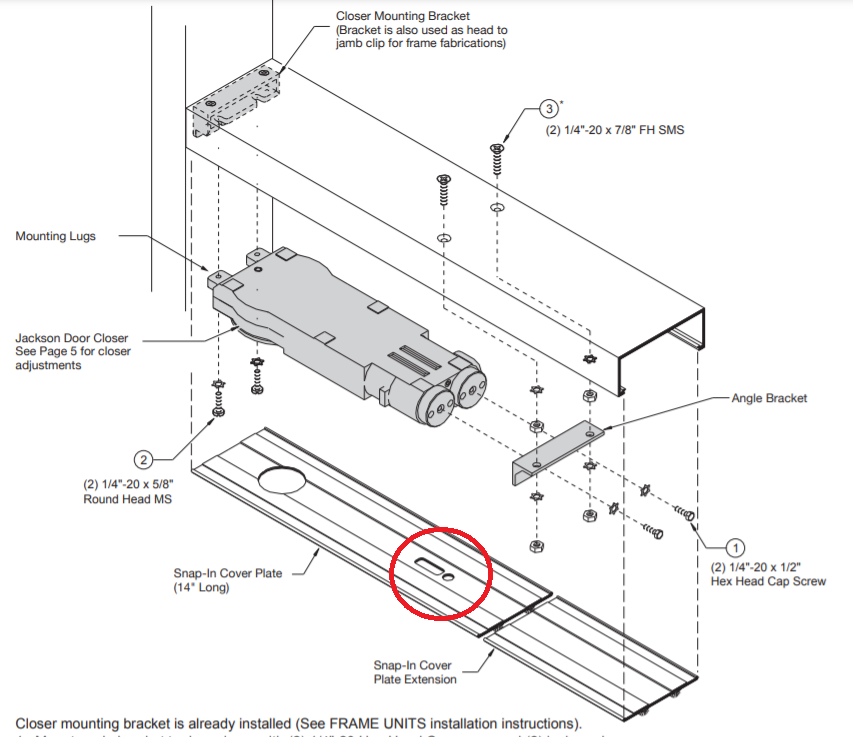![]()
A Guide To Adjusting Storefront Door Concealed Closers
A storefront concealed door closer is an automatic door closing device mounted within the door frame so that it is hidden from the public eye. It's main function is to smoothly close the storefront door each time a pedestrian or customer opens the door to enter or exit the building. The storefront concealed door closer is a mechanical-hydraulic design and comes standard with 2 adjustments, closing speed and latch speed. Concealed closers come in two full opening types, a 90 degree full open or a 105 degree full open. When we say full open we are talking about how far the door can swing open. Most commercial doors actually use the 105 degree full open concealed closer. This means when the door is fully pushed open by a customer, the door will swing open past 90 degrees and all the way up to 105 degrees.
![]()
Identifying Adjustments On Closer Body
Overhead concealed door closers are mounted inside of the header of the door frame. To access the adjustment valves, you must swing the door open so that you can see the cover plate at the bottom of the door frame header. The cover plate will have two holes in it which allow you to access the adjustment valves. Some concealed closers have three valves and will have three holes in the cover plate. If the cover plate for whatever reason do not have holes in the cover plate, then simply remove the cover plate so that the valve adjustments can be accessed.
![]()
Things To Know Before Adjusting
The #1 tip when adjusting any concealed door closer is to only turn the adjustment valves 1/8 turn at a time. Remember, the adjustment controls are just valves which control the flow of the hydraulic fluid within chambers inside of the concealed closer. If you unscrew any of the closing speed valves to far, hydraulic fluid will leak out of the closer body and the concealed closer body will lose all hydraulic pressure. When this happens the concealed closer is no longer usable or able to function and must be discarded. Avoid this and only adjust any valve 1/8 turn at a time.
Closing Speed Adjustment
Closing speed is the speed the storefront door closes from the full open position to about 20 degrees. The closing speed is always the valve closest to the center of the closer body. The adjustment is a valve. Turning the valve clockwise will close the valve, slowing the closing speed. Turning the valve counterclockwise will open the valve, increasing the closing speed. According to section 404.2.8 ADA requirements, the concealed closer should take atleast 5 seconds to close from 90 degrees to 12 degrees. Carefully adjust this valve 1/8 of a turn at a time until the closing speed is in compliance with ADA requirements.
Latch Speed Adjustment
The latch speed is the speed the storefront door closes from approximately 20 degrees to the full closed position. Section 404.2.8 of the ADA requirements does not specify a specific latch speed. However, concealed closers should never slam closed. The latch speed should be adjusted much slower than the main closing speed. You do not want the latch speed operating so fast that it could hurt someone fingers if they are reaching for the door. Turning the latch speed valve clockwise, closes or restricts the flow of hydraulic fluid and reduces the latch speed. Turning the latch speed valve counter-clockwise, opens the flow of hydraulic fluid and increases the latch speed. It is important to realize that if your latch speed has to be increased too high so that the door slams in order to get the door to fully latch, then the door has other problems. This could be too friction with the bottom door sweep, a bad pivot hinge, or possibly an incorrect concealed closer spring tension for your door. Remember, concealed closers are designed to safely control the door. Having an incorrectly adjusted latch speed that slams the door is very dangerous to any pedestrian that uses the door.
Backcheck
Backcheck is an optional third valve only found on some models of concealed closers.
![]()
Backcheck is the speed at which the door can open from approximately 80 degrees to the full open position. Backcheck is very useful in preventing the door from slamming open when pushed open with excessive force. Turning the backcheck valve clockwise will close the valve and increase the backcheck resistance allowing the door to open more slowly. Turning the backcheck valve counter-clockwise will open the valve and decreasing the backcheck resistance allowing the door open more quickly. It is important to note to never turn the backcheck valve completely closed, as this will stall the door from moving and put too much pressure on the closer body if the door is pushed or pulled, resulting in the o-ring seals to rupture, ruining the door closer.
![]()
Conclusion
Knowing the ADA requirements is very important so that you can adjust the storefront door concealed closer to compliance. Following ADA guidelines for the closing speed adjustments ensure safety for each customer or pedestrian that passes through your storefront door. If your concealed closer is defective, leaking oil, or not functioning properly, then we recommend the Liberty concealed door closer. The Liberty concealed door closer is designed for storefront doors and are ADA compliant. Shop today and receive FAST, FREE shipping!
![]()
![]()
DISCLAIMER:INFORMATION PROVIDED THROUGH THIS SITE IS PROVIDED TO YOU AS IS WITHOUT ANY EXPRESS REPRESENTATIONS OR WARRANTIES OF ANY KIND, AND WE MAKE NO REPRESENTATION OR WARRANTY THAT THIS SITE (OR ANY INFORMATION PROVIDED IN RESPONSE TO YOUR INQUIRY), WILL BE ACCURATE, COMPLETE, OR ERROR-FREE.YOU AGREE THAT YOU MUST EVALUATE ALL INFORMATION AND RESPONSES, AND THAT YOU BEAR ALL RISKS ASSOCIATED WITH, THE USE OF THIS SITE, INCLUDING ANY RELIANCE ON THE ACCURACY,COMPLETENESS, OR USEFULNESS OF ANY INFORMATION OR MATERIALS MADE AVAILABLE THROUGH THIS SITE.







